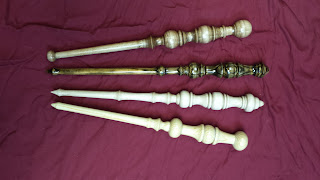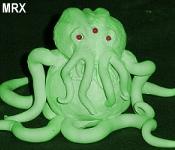For many years I have wanted to try my hand at wood turning, but I did not own or have access to a lathe. Well, a few moths ago, I broke down and bought a cheap midi-sized lathe from Harbor Freight, along with a set of gouges. I have been playing with it in short bursts, between other projects, since then, and I am just now getting to the point where I am beginning to be proud of the pieces I am producing.
And just what am I producing? Wands. Hand turned, wooden, magic wands, which I intend to sell in my shop.
Although I had wands in the back of my mind all along, my initial interest which prompted me to purchase the lathe was in producing pens- hand turned exotic wood executive style ink pens. If you have been to any gaming or hobby conventions like GenCon or ComiCon, you've probably seen people selling turned wood pens in one of the market booths. They are a fairly common and popular item among the kind of cottage industry woodworkers who make things like jewelry boxes and dice cups. And they are not cheap! Some of the exotic wood blanks for making these pens, in raw form and not including the pen hardware, can cost over $20 for a 3/4 square by 6 inch long stick. That's twenty bucks for a piece of raw wood the size of a piece of peal and eat cheese!
Eventually I came back to the lathe, and watched a LOT more YouTube videos on tool use and basic technique. And I watched quite a few that were specific to making magic wands. I watched, mesmerized, for hours while other people turned spindle after spindle- watching how they used the tools, watching how they approached the work, stealing design ideas, learning good turning technique, learning finishing techniques, figuring out what kinds of upgrades to my tools and accessories I would eventually need to invest in.
My second attempt at making wands gave me trouble at first, as the work piece would start to vibrate a lot while I was tapering the long shaft of the wand. Afraid I would break the piece again, I decided to just turn handles and add the shaft as a second piece made from a tapered hardwood dowel. So I made a dozen or so handles, usually two at a time, all from scrap lumber. I saw a good bit of improvement, but my skills were still fairly primitive.
Eventually, after watching even more YouTube videos, I solved my vibration problem and went back to making single piece wands. The handles looked nice, and were faster and easier to make, but I was having trouble getting the hole for the dowel to go in straight and centered. My first full sized single piece wand turned out well enough that I abandoned the two piece model, for the time being, and refocused on making single piece wands, like I had originally intended.
Now I was starting to really be happy with the pieces I was producing, and each new wand I made was my new favorite. I could honestly see a steady progression of improvement in my skill from one piece to the next. I learned how to apply stain and finish directly to the work piece while it is still on the lathe, which makes the finishing process much faster and easier. For finish, I'm using a combination of friction polish, or shine juice as it is sometimes called (which is a 1:1:1 mixture of shellac, boiled linseed oil and denatured alcohol) and CA (cyanoacrylate - also known as Super Glue). Surprisingly, CA makes a very hard, fast drying, incredibly durable, high gloss finish that is easy to apply, but the fumes are killer.
I now have nearly a dozen single piece wands, finished or nearly so, and about a dozen wand handles that I will finish eventually once I solve my drilling problem. I will probably throw out a few of the handles and maybe a few of the early single piece wands. I'm finally making pieces I am proud of, and some of my earlier attempts, though I was happy with them at the time, look sad in comparison. In fact, I just went out to Amish country and bought some moderately priced hardwood scraps and a few upgrades to my tools. I'm about to take my game to the next level, and who knows, maybe in a month or two I'll be ready to buy some of those exotic woods!
And now, the glamour shots of my first batch of finished wands.
The wand above is my first attempt at laminating two different kinds of wood together. I started with a piece of oak that was wide enough for the shaft but not wide enough for the handle. I glued a thin scrap of black walnut to either side in the handle area to thicken it up. When I turned it, only a little bit of the walnut remained, but it made a striking and beautiful pattern against the light oak.












































































